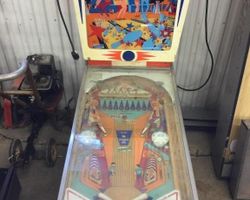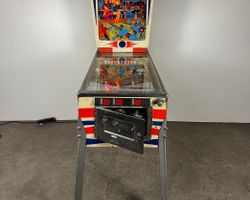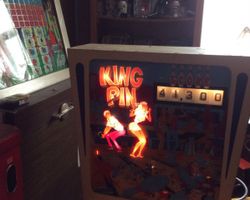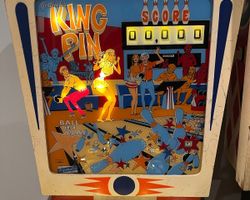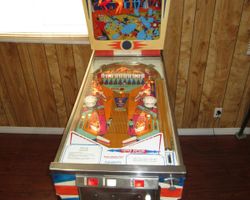King Pin
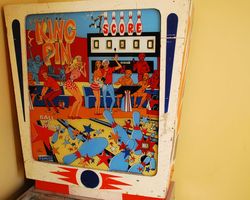
Average Prices: USD $400 to $1,200
Produced: November, 1973
Production Run: 4,350 units
Machine Type: Electro-mechanical
Players: 1
Design by: Ed Krynski
Art by: Gordon Morison
The Gottlieb King Pin pinball machine, released in December 1973, stands as a notable electro-mechanical (EM) era creation. Manufactured by D. Gottlieb & Co., a company with a strong pedigree in pinball design, King Pin captured the attention of players with its distinctive theme. Eschewing the more fantastical or abstract themes common at the time, King Pin embraced the familiar and competitive world of bowling, translating the sport's core objective into pinball mechanics. This thematic choice resonated with a broad audience, providing a relatable backdrop to the game's challenging playfield.
The development of King Pin was guided by the experienced hand of Ed Krynski, credited with the playfield design. Krynski was known for his knack for creating engaging EM layouts, often characterized by intricate shot opportunities and demanding skill requirements. Complementing Krynski's mechanical design was the vibrant artwork of Gordon Morison. Morison's illustrations brought the bowling alley theme to life, adorning the playfield and backglass with stylistic depictions of pins, bowling balls, and score-keeping elements that evoked the Americana of the 1970s. The production run for King Pin totaled 4,350 units, a respectable number for an EM game of its time, indicating a confident market projection from Gottlieb. Interestingly, King Pin also spawned two related variations: 'Pin-Up', an add-a-ball version released in 1975, and 'Ten-Up', an export-specific add-a-ball version for Italy, demonstrating Gottlieb's strategy of adapting popular designs for different markets and rulesets.
Signature Features and Design
King Pin distinguishes itself through several signature features that directly support its bowling theme and define its gameplay. The most prominent element is the central bank of ten drop targets, arranged in a triangular formation reminiscent of a rack of bowling pins. These targets are not merely static obstacles; they are the primary objective, with knocking them all down serving as the pinball equivalent of a "strike." The satisfying clatter as each target falls reinforces the thematic connection and provides immediate tactile feedback to the player.
Beyond the prominent drop targets, King Pin incorporates a four-flipper layout, a design choice that significantly impacts the game's flow and strategic depth. While two standard flippers are located at the bottom of the playfield, two smaller, two-inch flippers are strategically positioned higher up. These upper flippers are not extraneous additions; their integration is considered well-executed, proving essential for controlling the ball in the upper playfield and setting up critical shots toward the drop targets. Their presence necessitates a different style of play, encouraging players to master ball control beyond the lower flippers to maximize scoring opportunities. The artwork throughout the machine, from the backglass depicting bowlers in action to the playfield's lanes and pin graphics, works in concert with these features to create a cohesive and immersive experience. The colors are bright and inviting, ensuring visual appeal that aligns with the game’s recreational theme.
Playfield and Mechanics
The King Pin playfield is designed with a clear focus on its central bank of ten drop targets. The layout is relatively open, providing ample space for ball travel and shot setup, yet its simplicity belies the precision required for high scores. Starting from the manual plunger, players can attempt a skill shot that directs the ball into one of the top rollover lanes, often accompanied by a reward if executed cleanly. Below these lanes, two pop bumpers are situated, providing unpredictable deflections that can either aid or hinder a player's attempts at the main objectives.
The core gameplay revolves around hitting the large bank of ten drop targets. These targets are arranged centrally, making them accessible from various points on the playfield, yet challenging to clear entirely. Two stand-up targets flank the drop target bank, offering additional scoring opportunities and contributing to game progression. On either side of the playfield, two kick-out holes provide specific targets to aim for, often awarding 5,000 points or special bonuses when activated. The two upper, two-inch flippers are positioned strategically to control the ball in the upper portion of the playfield, offering crucial angles for direct shots at the drop targets or for navigating the ball back down to the main flippers. The slingshots above the lower flippers provide kinetic energy, deflecting the ball and adding to the unpredictable nature of gameplay. Gordon Morison's artwork throughout the playfield maintains the bowling alley aesthetic, with detailed lane markings, pin graphics, and thematic elements that immerse the player in the game's world. The lighting, while functional, focuses on illuminating the key playfield features, though some players note that the central area can sometimes appear dimmer, demanding greater familiarity with the layout. The overall design philosophy emphasizes direct shots and ball control, with the central drop targets acting as the magnetic center of attention.
Gameplay Dynamics
The gameplay dynamics of King Pin are built around a straightforward yet demanding scoring system focused heavily on the ten drop targets. The primary objective is to knock down all ten targets, mimicking a bowling strike. Achieving this feat resets the bank, often with increased point values for the subsequent completion, encouraging players to repeatedly clear the targets. This iterative challenge forms the backbone of the game’s progression. The scoring system primarily awards points for hitting targets, rollovers, and pop bumper activations, with higher scores typically reserved for completing the drop target bank and triggering kick-out hole awards. The maximum displayed point score is 99,990 points, a common limit for EM machines of the era.
Unique to King Pin's gameplay is the critical role of its four flippers. Players must master both the lower and upper flippers to control the ball effectively and make precise shots. The upper flippers are not merely for defense; they are integral to setting up powerful shots on the drop targets or directing the ball into the kick-out holes for bonus points. Strategic play involves learning how to cradle the ball with the lower flippers to aim for the upper flippers, then utilizing those smaller flippers to clear the target bank. The game offers a demanding experience, largely due to its "greedy" outlanes, which are known for their propensity to drain balls, adding a layer of challenge that demands precise flipper work and nudging skills. Despite the seemingly simple ruleset, the pursuit of clearing the drop targets and achieving high scores creates an addictive "one more game" appeal. For instance, a player might aim to clear the initial drop target bank, then strategically use the upper flippers to clear it a second time for a higher bonus, demonstrating an understanding of the game's progressive scoring.
Reception and Legacy
King Pin has garnered a strong and generally positive reception within the pinball community, solidifying its place as a classic Gottlieb EM machine. Its primary strength lies in its central bank of ten drop targets, which players find immensely satisfying to clear, often comparing the achievement to hitting a bowling strike. This core mechanic, combined with the challenge of its four-flipper layout, contributes to a gameplay experience that many describe as addictive and rewarding. The game's difficulty, characterized by demanding shot accuracy and unforgiving outlanes, is frequently cited as both a strength and a weakness. While some players appreciate the challenge and the skill required to keep the ball in play, others find the punishing outlanes lead to frustration and quick drains.
The integration of the two upper, two-inch flippers is a point of discussion. While many enthusiasts praise their utility and the strategic depth they add, requiring precise shots and ball control, a segment of players finds them occasionally disruptive or difficult to utilize effectively, sometimes impeding shots from the lower flippers. However, the prevailing view is that their presence elevates the gameplay beyond a typical two-flipper EM machine. The bowling theme and Gordon Morison's artwork are consistently well-received, lauded for their vibrant aesthetic and thematic coherence, evoking a sense of nostalgia for the era.
King Pin's legacy is primarily that of a challenging and enduring EM pinball machine. It stands as a testament to Ed Krynski's design philosophy, emphasizing direct playfield objectives and requiring significant player skill. Often compared to other Gottlieb "wedgehead" machines like "Jumping Jack" or "El Dorado," King Pin is frequently cited as a more challenging and perhaps more engaging experience due to its unique flipper configuration and the central drop target array. Its sustained appeal among collectors is due to its robust EM mechanics, the tangible satisfaction of its primary objective, and its ability to continually test a player's precision and ball control. The machine continues to be a sought-after classic, appreciated for its blend of thematic charm and demanding gameplay, contributing to the rich tapestry of Gottlieb's EM era.
Sponsored Links
 Ebay Listings
Ebay Listings
 Auction Results
Auction Results
| Cost | Location | Date |
|---|---|---|
| USD $350 |  United States United States |
10 July, 2025 |
| EUR €800 |  Netherlands Netherlands |
22 March, 2025 |
| GBP £770 |  United Kingdom United Kingdom |
24 June, 2024 |
| USD $1,395 |  North Carolina, United States North Carolina, United States |
02 May, 2024 |
| USD $1,988 |  Florida, United States Florida, United States |
19 January, 2024 |
| USD $300 |  New Jersey, United States New Jersey, United States |
19 January, 2023 |
| USD $2,888 |  Florida, United States Florida, United States |
25 June, 2022 |
| USD $2,450 |  Utah, United States Utah, United States |
12 May, 2022 |
| USD $2,000 |  Florida, United States Florida, United States |
17 October, 2021 |
| USD $800 |  United States United States |
10 September, 2021 |


Private Policy · Search Website · Contact Us
As an eBay Partner, we may earn a commission from qualifying purchases made through links on this site, at no additional cost to you.
All trademarks and copyrighted materials remain property of their respective owners. All other content copyright 2007 - 2025 Pinpedia.


